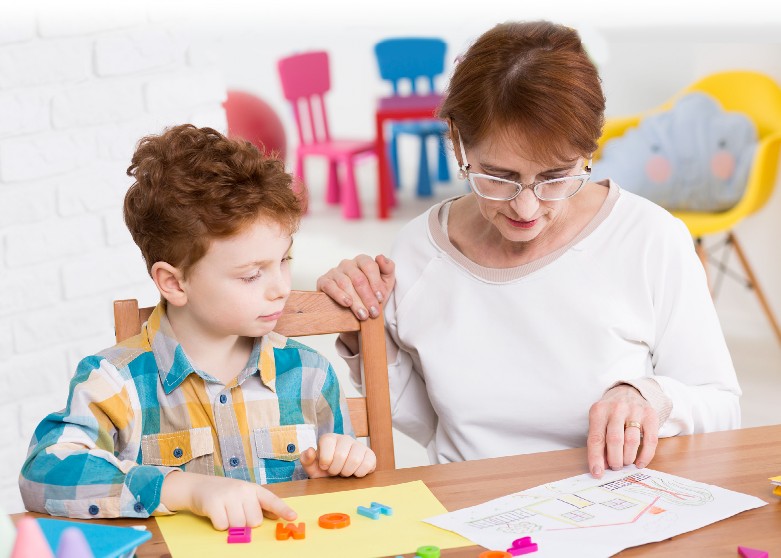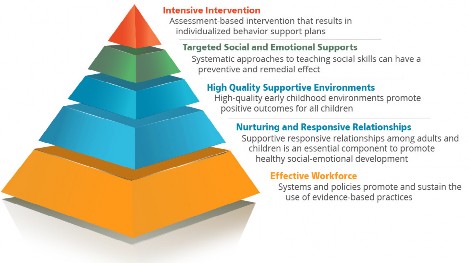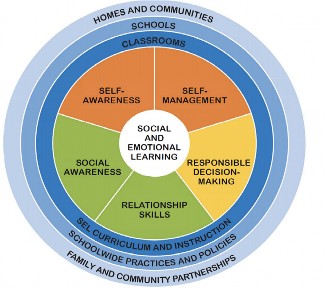SEL, or Social-Emotional Learning, helps students make academic gains. This is particularly true for students with autism spectrum disorder.
HOW SOCIAL-EMOTIONAL LEARNING HELPS STUDENTS WITH AUTISM ACHIEVE
BY LAUREN AGORATUS, M.A.
WHAT IS SEL?
The Center on the Social Emotional Foundations for Early Learning (CSEFEL) uses a Pyramid Model to illustrate the application of social emotional targeted strategies to support children's healthy development. This framework uses tiered research- and evidence-based strategies to meet the needs of all children, including those with social-emotional challenges. The Pyramid Model approach is supported by an effectively trained team that includes parents, teachers, principals, program directors, early intervention providers, social workers, and other early care and education professionals.

The bottom tier in the pyramid promotes skills that early care educators need to build nurturing and responsive relationships with young children. These relationships within a high-quality supportive environment allow children to engage in reciprocal relationships with teachers and their peers. Within this tier, all children benefit from techniques that support social emotional development. For children who need a little more support than the bottom tier, another layer of intervention provides techniques that target socialemotional development and acquisition of related skills. Children are provided with continuous supports embedded within the activities and routines of the program day. Research has found that when young children are provided with the universal and targeted interventions, fewer are identified as needing intensive intervention. However, the Pyramid Model also addresses those children needing intensive intervention. In the top tier, children are individually assessed to determine what additional supports can be adopted within the Framework that best work with that child. The Pyramid Model is uniquely appropriate for students with autism spectrum disorders (ASD). Because autism is a spectrum disorder, some students will benefit from the universal, lower level interventions, while others may need targeted or even intensive supports.

GREAT PYRAMID: The Pyramid Model is uniquely appropriate for students with autism spectrum disorders. Some students will benefit from the universal, lower level interventions, while others may need targeted or even intensive supports.
In Early Intervention for children from birth to age three, SEL is extremely important to set the foundations. Many states, including NJ, have selected this as the state-identified measurable result for the State Systemic Improvement Plan (SSIP). According to the Early Childhood Technical Assistance Center (ECTA), the three child outcomes are:
- 1.Children have positive social-emotional skills (including social relationships).
- 2.Children acquire and use knowledge and skills (including early language, communication, and literacy).
- 3.Children use appropriate behaviors to meet their needs.
Social interaction, emotional regulation, social problem solving, and behavior are key skills for children in early intervention. For more information on SEL and early intervention, see ectacenter.org/eco/pages/childoutcomes.asp
For older students, the Center for Academic, Social, and Emotional Learning (CASEL) defines SEL as students gaining the skills to:
- ➢Understand and manage emotions
- ➢Set and achieve positive goals
- ➢Feel and show empathy for others
- ➢Establish and maintain positive relationships
- ➢Make responsible decisions
- ➢Understand and follow routines and activities
- ➢Have positive interactions with peers and teachers Related Core Competencies include:
- ➢Self-awareness
- ➢Self-management
- ➢Social awareness
- ➢Relationship skills
- ➢Responsible decision-making
Students with autism may need assistance with any or all of these. It is essential that early care and education professionals look at behavior as a skill as opposed to a compliance issue. The child with autism may "act out" because s/he doesn't know what is expected or have the communication and/or coping skills needed to behave as expected. Discipline shouldn't be punitive but rather geared towards acquisition of knowledge and skills.
HOW SEL CAN HELP STUDENTS WITH AUTISM
According to the American Psychiatric Association's Diagnostic and Statistical Manual, 5th edition (DSM-V), the diagnostic criteria for autism includes, among other things:
- • Problems reciprocating social or emotional interaction, including difficulty establishing or maintaining back-and-forth conversations and interactions, inability to initiate an interaction, and problems with shared attention or sharing of emotions and interests with others
- • Severe problems maintaining relationships – ranges from lack of interest in other people to difficulties in pretend play and engaging in age-appropriate social activities, and problems adjusting to different social expectations.
- • Nonverbal communication problems such as abnormal eye contact, posture, facial expressions, tone of voice and gestures, as well as an inability to understand these.1
Due to the nature of the disability of autism, skill deficits exist in the areas of social emotional learning. By addressing SEL in students with autism, these areas can be addressed.
SEL BENEFITS FOR STUDENTS ON THE SPECTRUM
Research shows the SEL improves attendance, reduces problem behaviors, builds confidence, increase peer interactions, and improves grades (Durlak, J.A., et al, 2011). It is a given that children must be present to learn. Reducing disruptive behaviors will lead to a better learning environment for both teachers and stu dents. Academic achievement is enhanced when behaviors are appropriately addressed and teachers are equipped with techniques that support child/student confidence.
HOW FAMILIES AND PROFESSIONALS CAN HELP THE CHILD
- CSEFEL has tools for professionals and parents. Topics for families include:
- ➢Teaching Your Child to Identify and Express Emotions
- ➢Making the Most of Playtime
- ➢Teaching Your Child about Feelings
- ➢Teaching Your Child to Become Independent with Daily Routines
- ➢Teaching Your Child to Cooperate with Requests
- ➢Responding to Your Child's Bite
- ➢Understanding Your Child's Behavior

HIGH FIVE: CASEL's widely used framework identifies five core competencies reinforcing social and emotional learning. SEL is the process through which children and adults understand and manage emotions, set and achieve positive goals, feel and show empathy for others, establish and maintain positive relationships, and make responsible decisions.
There are also Tip Sheets on nurturing social emotional development, relationship building, communication, self-control, aggression, and challenging behaviors. Lastly, there are more in-depth parent modules which cover connecting with your child, explaining behavior, and how to handle behaviors.
Tools for professionals include social stories, building relationships, book lists, teaching social emotional skills, and developing behavioral support plans (see Resources). In addition to teaching skills, perhaps the most important factor in school success is the use of appropriate behavioral support plans. Being proactive by preventing, rather than reacting (or over-reacting!) to challenging behaviors, academic and social achievement will be facilitated. This is particularly true of eliminating the inappropriate use of restraints and seclusion, which traumatize students and are ineffective at behavioral modification, and have life-long adverse impacts on the child. Rather, the use of Positive Behavioral Interventions and Supports in IEPs (Individualized Education Plans) is more effective. By utilizing the concepts found in Social Emotional Learning, students with autism and their teachers will be more successful.•
ABOUT THE AUTHOR: Lauren Agoratus, M.A. is the parent of a young adult with multiple disabilities. She serves as the State Coordinator for Family Voices-NJ and as the central/southern coordinator in her state's Family-to-Family Health Information Center. FVNJ and F2FHIC are both housed at the SPAN Parent Advocacy Network (SPAN) at spanadvocacy.org. This article was also supported by Denise Bouyer-Hargrove, the Director of SPAN's NJ Inclusive Child Care Project, Family Engagement Chairperson of NJ State Leadership Team for the Pyramid Model, Certified Trainer for the Pyramid Model, Teaching Pyramid Observation Tool (TPOT), and Teaching Pyramid Infant Toddle Observation Scale (TIPTOS), for parents and professionals.
BUILDING THE PYRAMID : SEL RESOURCES
CENTER ON THE SOCIAL AND EMOTIONAL FOUNDATIONS FOR EARLY LEARNING: CSEFEL csefel.vanderbilt.edu Practical Strategies for Teachers csefel.vanderbilt.edu/resources/strategies.html Tools for Families csefel.vanderbilt.edu/resources/family.html
COLLABORATIVE FOR ACADEMIC, SOCIAL, AND EMOTIONAL LEARNING: CASEL casel.org Benefits to Schools casel.org/wp-content/uploads/2019/12/Practical-Benefits-of-SEL-Program.pdf How to Implement SEL casel.org/resources-support Information for Families youtube.com/watch?v=y2d0da6BZWA
POSITIVE BEHAVIORAL INTERVENTIONS AND SUPPORTS: PBIS pbis.org PBIS for schools pbis.org/resource-type/materials#disability